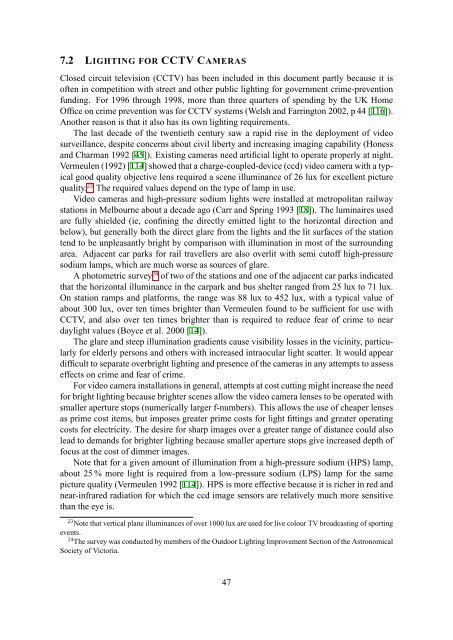outdoor lighting and crime, part 1 - Astronomical Society of Victoria
outdoor lighting and crime, part 1 - Astronomical Society of Victoria
outdoor lighting and crime, part 1 - Astronomical Society of Victoria
You also want an ePaper? Increase the reach of your titles
YUMPU automatically turns print PDFs into web optimized ePapers that Google loves.
7.2 LIGHTING FOR CCTV CAMERAS<br />
Closed circuit television (CCTV) has been included in this document <strong>part</strong>ly because it is<br />
<strong>of</strong>ten in competition with street <strong>and</strong> other public <strong>lighting</strong> for government <strong>crime</strong>-prevention<br />
funding. For 1996 through 1998, more than three quarters <strong>of</strong> spending by the UK Home<br />
Office on <strong>crime</strong> prevention was for CCTV systems (Welsh <strong>and</strong> Farrington 2002, p 44 [116]).<br />
Another reason is that it also has its own <strong>lighting</strong> requirements.<br />
The last decade <strong>of</strong> the twentieth century saw a rapid rise in the deployment <strong>of</strong> video<br />
surveillance, despite concerns about civil liberty <strong>and</strong> increasing imaging capability (Honess<br />
<strong>and</strong> Charman 1992 [45]). Existing cameras need artificial light to operate properly at night.<br />
Vermeulen (1992) [114] showed that a charge-coupled-device (ccd) video camera with a typical<br />
good quality objective lens required a scene illuminance <strong>of</strong> 26 lux for excellent picture<br />
quality. 23 The required values depend on the type <strong>of</strong> lamp in use.<br />
Video cameras <strong>and</strong> high-pressure sodium lights were installed at metropolitan railway<br />
stations in Melbourne about a decade ago (Carr <strong>and</strong> Spring 1993 [18]). The luminaires used<br />
are fully shielded (ie, confining the directly emitted light to the horizontal direction <strong>and</strong><br />
below), but generally both the direct glare from the lights <strong>and</strong> the lit surfaces <strong>of</strong> the station<br />
tend to be unpleasantly bright by comparison with illumination in most <strong>of</strong> the surrounding<br />
area. Adjacent car parks for rail travellers are also overlit with semi cut<strong>of</strong>f high-pressure<br />
sodium lamps, which are much worse as sources <strong>of</strong> glare.<br />
A photometric survey 24 <strong>of</strong> two <strong>of</strong> the stations <strong>and</strong> one <strong>of</strong> the adjacent car parks indicated<br />
that the horizontal illuminance in the carpark <strong>and</strong> bus shelter ranged from 25 lux to 71 lux.<br />
On station ramps <strong>and</strong> platforms, the range was 88 lux to 452 lux, with a typical value <strong>of</strong><br />
about 300 lux, over ten times brighter than Vermeulen found to be sufficient for use with<br />
CCTV, <strong>and</strong> also over ten times brighter than is required to reduce fear <strong>of</strong> <strong>crime</strong> to near<br />
daylight values (Boyce et al. 2000 [14]).<br />
The glare <strong>and</strong> steep illumination gradients cause visibility losses in the vicinity, <strong>part</strong>icularly<br />
for elderly persons <strong>and</strong> others with increased intraocular light scatter. It would appear<br />
difficult to separate overbright <strong>lighting</strong> <strong>and</strong> presence <strong>of</strong> the cameras in any attempts to assess<br />
effects on <strong>crime</strong> <strong>and</strong> fear <strong>of</strong> <strong>crime</strong>.<br />
For video camera installations in general, attempts at cost cutting might increase the need<br />
for bright <strong>lighting</strong> because brighter scenes allow the video camera lenses to be operated with<br />
smaller aperture stops (numerically larger f-numbers). This allows the use <strong>of</strong> cheaper lenses<br />
as prime cost items, but imposes greater prime costs for light fittings <strong>and</strong> greater operating<br />
costs for electricity. The desire for sharp images over a greater range <strong>of</strong> distance could also<br />
lead to dem<strong>and</strong>s for brighter <strong>lighting</strong> because smaller aperture stops give increased depth <strong>of</strong><br />
focus at the cost <strong>of</strong> dimmer images.<br />
Note that for a given amount <strong>of</strong> illumination from a high-pressure sodium (HPS) lamp,<br />
about 25 % more light is required from a low-pressure sodium (LPS) lamp for the same<br />
picture quality (Vermeulen 1992 [114]). HPS is more effective because it is richer in red <strong>and</strong><br />
near-infrared radiation for which the ccd image sensors are relatively much more sensitive<br />
than the eye is.<br />
23Note that vertical plane illuminances <strong>of</strong> over 1000 lux are used for live colour TV broadcasting <strong>of</strong> sporting<br />
events.<br />
24The survey was conducted by members <strong>of</strong> the Outdoor Lighting Improvement Section <strong>of</strong> the <strong>Astronomical</strong><br />
<strong>Society</strong> <strong>of</strong> <strong>Victoria</strong>.<br />
47
















